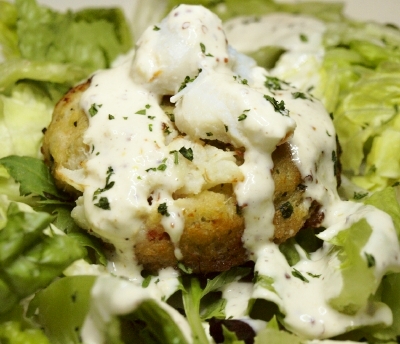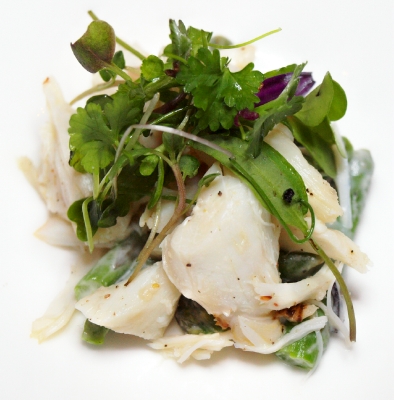Our annual survey of seafood in Southeast Louisiana this year counts down the 33 best edible seafood species. The sub-theme this year is that these seafoods are more common in restaurant than in homes--unless your home has crabnets in nearby waters. In this entry we look at all forms of the local blue crab.

#5: Hard Crabs, Soft Crabs And Crabmeat
The favorite trick of waiters and chefs is making an ordinary dish seem irresistible by just throwing a little crabmeat on top. That's how appealing crabmeat is. And with good reason. Aside from people who are allergic to it, who doesn't love crabmeat? Even so, using crabmeat as a price-elevating garnish is the least interesting way to use this fantastic local seafood. The best way is to serve it more or less as it comes out of the crab's shell. If there's a sauce, it should be a light one. The subtle flavor of our local blue crab is so distinguished that it needs no help. Stone crab claws, king crab, snow crab legs, and other exotic crabs from around the world find their way onto New Orleans table. At the bottom of the spectrum is the fake crabmeat in sushi bars. I'd trade any or all of it gladly for the meat of our local blue crab (hereinafter called simply "crabmeat"). It reigns supreme. Crabmeat is found in several forms, listed here from the most expensive to the least: Marbles. These are the largest lumps from the biggest male crabs. Expensive and uncommon.
Jumbo lump. This is the big lump of meat from the point where the paddle-like "backfin" legs are attached to the body. There's a little sliver of thin shell in there that's difficult to remove without breaking the lump. A sign that you're eating the best crabmeat is the presence of a little bit of shell. Restaurants buy almost all the jumbo lump in the market. Even in the best of times, the price per pound rarely drops below about $20, and it often reaches $30.
Lump. This comes from beneath the place where the crab's claws attach to the body. It tastes as good as the jumbo lump, but it's not as eye-popping. Great for crabmeat ravigote, crabmeat au gratin, crab cakes, and dishes like those.
Special white. This is white meat from inside the crab, but it's usually shredded. The flavor is not bad, but the look isn't as good as lump. There's a lot of inconsistency from one container to the next, and even between the meat on top and on the bottom of the same container. Good for making soups and sauces, and for topping things like baked fish.
Claw crabmeat is the least expensive, but has the most assertive flavor of any part of the crab. It's perfect for stuffings or dressings. It doesn't look as good, however--the meat is dark and stringy. So it's the cheapest kind of crabmeat, universally available wherever crabmeat is sold.
Marbles. These are the largest lumps from the biggest male crabs. Expensive and uncommon.
Jumbo lump. This is the big lump of meat from the point where the paddle-like "backfin" legs are attached to the body. There's a little sliver of thin shell in there that's difficult to remove without breaking the lump. A sign that you're eating the best crabmeat is the presence of a little bit of shell. Restaurants buy almost all the jumbo lump in the market. Even in the best of times, the price per pound rarely drops below about $20, and it often reaches $30.
Lump. This comes from beneath the place where the crab's claws attach to the body. It tastes as good as the jumbo lump, but it's not as eye-popping. Great for crabmeat ravigote, crabmeat au gratin, crab cakes, and dishes like those.
Special white. This is white meat from inside the crab, but it's usually shredded. The flavor is not bad, but the look isn't as good as lump. There's a lot of inconsistency from one container to the next, and even between the meat on top and on the bottom of the same container. Good for making soups and sauces, and for topping things like baked fish.
Claw crabmeat is the least expensive, but has the most assertive flavor of any part of the crab. It's perfect for stuffings or dressings. It doesn't look as good, however--the meat is dark and stringy. So it's the cheapest kind of crabmeat, universally available wherever crabmeat is sold.
 Whole boiled hard-shell crabs. This form may be the ultimate way to eat crabmeat, because you have all of the above in there. At the peak of the season--the beginning of the summer--it can't be beat, even though it's a lot of work. (It's always seemed to me that eating boiled crabs will cause you to lose weight, because you expend more energy than you get from the crab.)
Crabmeat has shot up in price in recent years because our crabs have become part of the national market. The people along the Chesapeake Bay--who have the same kind of crabs we do and a similar crab-eating culture--buy up a titanic quantity of our crabs. The meat is in demand all across the nation.
On the other hand, producers of crabmeat in South America and Asia have entered the market with pasteurized crabmeat in sealed cans. It's much cheaper, and for the price it's not terrible, but it has nothing on fresh local crabmeat.
Crabmeat is one of our great delicacies. The season for crabmeat is just beginning now. Enjoy it!
And then we have soft-shell crabs. These are almost all farm-raised, because the critical moment in grabbing the soft-shell crabs involves monitoring the crabs more or less constantly. They are removed from the water the moment the old shell comes off. If that moment is missed, the crab's new shell begins to stiffen to the consistency of paper. Not good.
The best soft-shell crabs of all are the ones that have their shells removed by hand. The meat at that point is at its peak of flavor. When the crab jettisons it old shell, it starts pumping itself up to its new size with water, diluting the flavor. The pre-molting crab is called a "buster" crab. We don't see them much anymore. A buster almost always has a few legs missing from the ordeal.
As excellent as soft-shell crabs are, their range of recipes is limited by a hard-to-escape fact: soft-shells are best deep-fried. All efforts to broil or grill the crab never top the ftid crabs. All the uniqueness comes from the sauces and garnishes.
Whole boiled hard-shell crabs. This form may be the ultimate way to eat crabmeat, because you have all of the above in there. At the peak of the season--the beginning of the summer--it can't be beat, even though it's a lot of work. (It's always seemed to me that eating boiled crabs will cause you to lose weight, because you expend more energy than you get from the crab.)
Crabmeat has shot up in price in recent years because our crabs have become part of the national market. The people along the Chesapeake Bay--who have the same kind of crabs we do and a similar crab-eating culture--buy up a titanic quantity of our crabs. The meat is in demand all across the nation.
On the other hand, producers of crabmeat in South America and Asia have entered the market with pasteurized crabmeat in sealed cans. It's much cheaper, and for the price it's not terrible, but it has nothing on fresh local crabmeat.
Crabmeat is one of our great delicacies. The season for crabmeat is just beginning now. Enjoy it!
And then we have soft-shell crabs. These are almost all farm-raised, because the critical moment in grabbing the soft-shell crabs involves monitoring the crabs more or less constantly. They are removed from the water the moment the old shell comes off. If that moment is missed, the crab's new shell begins to stiffen to the consistency of paper. Not good.
The best soft-shell crabs of all are the ones that have their shells removed by hand. The meat at that point is at its peak of flavor. When the crab jettisons it old shell, it starts pumping itself up to its new size with water, diluting the flavor. The pre-molting crab is called a "buster" crab. We don't see them much anymore. A buster almost always has a few legs missing from the ordeal.
As excellent as soft-shell crabs are, their range of recipes is limited by a hard-to-escape fact: soft-shells are best deep-fried. All efforts to broil or grill the crab never top the ftid crabs. All the uniqueness comes from the sauces and garnishes.